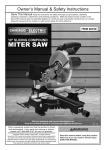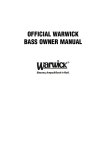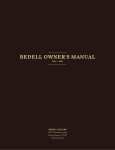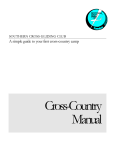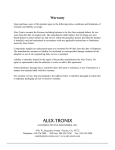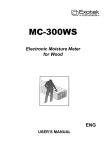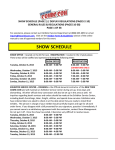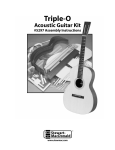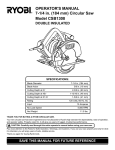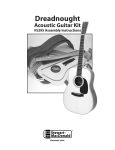Download U.S. Guitar Kits Cutaway Specifications
Transcript
U.S. Guitar Kits, Inc. Assembly Instructions for Acoustic Cutaway Guitar Kit Welcome Thank you for purchasing the kit. All the guitar components needed to build your guitar are included to build a fine instrument. You will need glue, finish, a variety of ordinary woodworking tools and average woodworking skills. Knowledge of the use and sharpening of scrapers is crucial and included is a set of instructions for this tool from a tool supplier. Please note that although we warrant this kit to be free from defects in materials and workmanship for 30 days from purchase, we cannot guarantee the outcome of your instrument since skill levels vary greatly. If you take your time and follow these instructions precisely and in the order in which they are presented you will be rewarded with an instrument of which you can be proud for a lifetime. Take your time, work carefully. Please keep your kit sealed until ready to use to avoid problems due to moisture and humidity. We will not replace parts that have been affected by moisture. Always use safe methods while working and employ all safeguards including safety glasses and other personal safety devices. Copyright © 2011 by U.S. Guitar Kits, Inc. All rights reserved. 2 Tools, Jigs and Materials - 25-30 Spool Clamps; - Small router or laminate trimmer; - a rabbeting bit set that includes the following cuts; 1) 1” Cutting Diameter Bit 2) .88” Bearing-Binding Cut 3) .48 – Six Pieces of Purfling 4) .64 – Five Pieces of Purfling 5) .70 – Four Pieces of Purfling The set is available from www.usguitarkits.com or available as separate items. Determine the number of purfling strips to be used and select the appropriate bearing (.48, .64 or .70). The .88” is used for the thicker binding strip on both the top and back. - a ½” diameter or smaller flush trim router bit. Ball bearing pilot is strongly recommended; - 1 F-style clamp; - A STRAIGHT straightedge at least 18” long; - a selection of small flat chisels- ¼” and ½” are required, 1/8” chisel and others are nice to have; - flat scrapers - a utility knife AND an Exacto® type knife; - #1 & #2 phillips screwdrivers and a 10mm deep socket with handle or equivalent open end wrench; - a shot filled hammer with plastic or brass heads (or both); - a tapered reamer (plumbers reamer) 3 & 5 degree or one 1/8” to ½” - a selection of drill bits including 3/8”, .065”/1.7mm, .182”/4.6mm, .056”/1.4mm; - a roll of blue painters tape (or other strong tape that does not leave a residue) OR some (25 to 30) big fat rubber bands measuring at least 16” to 24” long when stretched; - choice of aliphatic resin (Titebond) or liquid hide glue; - bottle of slow setting gel cyanoacrylate glue and a bottle of accelerator, de-bonder recommended to un-stick fingers; - tube of Duco® cement or similar clear plastic-to-wood glue; - acetone; - some scrap wood blocks of varying sizes; - a 20” radius sanding block including 80, 120 & 220 grit adhesive backed sandpaper; 2 3 - 400, 600, 1000, 1500 grit sponge sanding pads, higher grit micromesh pads are optional depending on the desired sheen of the fingerboard; - a fret crowning file; - a small triangular file; - a bastard mill file; - a good wipe-on gel finish. Avoid stain and oil finishes and give preference to hard finishes such as lacquer or urethane. Avoid Minwax® (sorry). A final word before you start- It is highly recommended that you read ALL of the assembly instructions first, then go back and start assembly. Although it may not make sense to you be sure to follow the instructions in precise sequence or you may have to disassemble parts or even start over. Also, be sure to read and understand the use and care of all tools and wear the proper safety equipment including but not limited to safety glasses, hearing protection and all guards that are part of the equipment used. It is important to note that this is a fine project that takes time and very precise measurement. Be sure to take your time on each step and ALWAYS be safe using the tools during your woodworking projects. Also, be in the right frame of mind where your mind is clear and not distracted. Stay focused and you’ll be more likely to remain safe and end up with a nice guitar. Good Luck! 3 4 Guitar Terms & Anatomy The guitar is made up of several components. The following list is a list of those components that can be cross referenced to the diagram for easy identification. Not illustrated are: 1) Frets-Hammered/Pressed into the Fingerboard 2) Abalone Dots & 12th Position Marker-Glue into the Fingerboard 3) Kerfed Lining-Pre-glued to inside of soundbox where the sides meet the top & back 4) Bracing-Pre-glued to top & back 5) Binding & Purfling-Glued to the perimeter of top & back where it meets the sides 4 5 Anatomy of the Top-Brace Structure The top is pre-braced and you will begin by marking and cutting bracing and then thinning out the bracing on the ends to fit into the kerfed lining on the sides of the guitar. Note: Identifying the braces. See picture. Note: The bracing on the top consists of the Shoulder Brace, an X-Brace, 2 Tone Bars and 2 small Finger Braces as well as a Bridge Plate. It is important to note that the only braces that touch the lining are the shoulder brace and X-braces. All the others are scalloped flush to the back of the top and cut short of the sides and kerfed lining. 5 6 Main Objective: You must first make a paper template and convert that to a plywood template that will be used in marking, dry fitting and final glue up of the top to the body. Step One – Making a paper template • Take a piece of paper as big as the back of the guitar or tape a few pieces of paper together to make a sheet as big as the back. • Carefully trace the outline of the back of the guitar onto the sheet and cut out the paper template. Step Two – Making a Plywood Template • Transfer the paper template to a piece of ¾” plywood. • Drill or cut a 4” hole in the template at the rough location of the sound hole. o The hole will give access for clamping the neck plate. As long as the hole is reasonably close, you’ll be fine. Step Three – Locating and Marking the Top • Mark the centerline on the guitar top and the plywood template. • Place the top on the body with the shoulder brace initially touching the end of the neck plate. • Move the top slightly back (1/16”-1/8”) so that the shoulder brace does not touch the end of the neck plate. Note: If the shoulder brace and the neck plate touch, it could cause an undesirable vibration later on. • Without moving the top, carefully place the plywood template over the top so that the neck end of the template is flush with the end of the sides and is centered on the top and body. • Mark the excess (waist material) that will be trimmed from the top. 6 7 Step Four – Marking the Brace Locations on the Plywood Template • Locate the bracing and transfer the marks onto the plywood template. This will require that the top NOT move during any of the marking. Step Five – Stretching the Sides • Using a flexible tape measure, measure the distance between the kerfed lining on the back at the widest part of the guitar. • Using the wooden shipping stretcher, take the previous measurement and add ¼” (equal to the kerfed lining on both sides). • Cut the stretcher to that length and slightly round the ends so that the sharp corners don’t damage the sides when installed. • Cut the stretcher almost all the way through, put a shim in the kerf cut and re-tape it back together using blue tape. This is done so that once the top is glued on, the tape can be removed and the stretcher can be broken and removed through the sound hole. Otherwise, the stretcher could become lodged and difficult to remove. • Slowly and gently spread the sides to install the stretcher below where the top will install by approximately 1”. If it sits to close to the top, the stretcher will interfere with the braces of the top. 7 8 • Sight down the sides of the guitar to ensure the sides do not appear to be bowed inward. You should be dead on. If not, modify the length of the stretcher either longer or shorter to correct any bow in the sides. • Once the stretcher is in place and the sides are “true”, leave it in place during the entire process all the way through the glue up of the top. Step Six – Positioning the Plywood Template • Use two spool clamps and position the plywood template and the guitar top so they are flush at the ends. o You’ll notice that the side of the body may not match the plywood template at the point….no worries. Step Seven – Clamping the Plywood Template • Using firm pressure, push the sides in flush with the plywood template and clamp using the spool clamps. o Note the difference with just two clamps in position. o This will ensure the top remains flat and any body twists are eliminated. o This allows for accurate marking locations for the kerfing/lining pockets. 8 9 Step Eight - Marking the Brace Locations on the Body • Transfer the bracing marks on the plywood template to the sides. • Connect the marking lines of the braces for the pocket locations in the kerfing/lining. Step Nine – Trim the Top • Trim the top using a band saw or coping saw. Note: You must use a fine blade and a slow feed rate if you are using a band saw. Because you are cutting with the bracing on the table, the top is unsupported in areas and has the potential to crack with too fast or aggressive cut. Take your time! Step Ten – Mark the Braces for the Length Cut • Mark the ends of the bracing in from the perimeter of the top by the thickness of the sides (3/32”), not including the kerfing/lining. Note: The ends of the braces will sit into a pocket you will cut in the kerfing/lining and not all the way through the side. 9 10 Main Objective: The next steps are focused on trimming, shaping and fitting the braces on the top. Step Eleven – Trimming the Brace Ends • Mark the ends of bracing that will touch the side kerfing 3/32” thick or simply lay a sharp pencil flat on the back and mark the ends of the bracing. • Scallop the end of the bracing to the 3/32” mark. • The shoulder brace can be left thick as this does not dramatically change the overall sound. Using a sharp chisel, follow the existing curve of the brace and reshape the end to be 3/32” thick. Alternative to Step 11: Using a small laminate router, cantilever it over the workbench on a piece of 1” scrap and use a ½” straight cutter set at a height that will cut the brace to 3/32” high. (Be sure to cut a test piece.) With the top face down, pass the ends of the x-braces and shoulder brace under the cutter to trim the ends. Now scallop the braces to the new height of the ends of the braces. This method will ensure a uniform height for all the braces. A Dremel tool with a base and a small straight cutter could be used to trim the lining, being careful not to cut all the way through the sides of the guitar. See the attached photo. Note: Be sure to review pages 11-15 for tips and information on scalloping the braces. Note: When you are using a chisel and creating constant downward pressure to thin your bracing, be sure to rest the top on a hard surface. If you use a spongy non-skid pad to rest the top on, you risk significant flex and possible damage to the top. Be careful…be gentle!! 10 11 Step 12 - Scalloping the ends of the Tone Braces • Place the top face down on a clean non slip surface. Cut the bracing off flush with the back of the top. Be careful not to make cuts/divets in the back of the top with the saw. You will need to chisel the small pieces off being careful NOT to pry and risk cracking the top or separating the brace from the top. Once removed, lightly scrape the surface where the brace was glued to ensure a clean surface to glue the top to the sides. Note: The ends of the tone braces do not touch the sides of the guitar. Mark the brace for scalloping. Note: Mark the trim line approximately 1/8” back from the existing curve and follow the same curve. Scalloping the end of the tone brace. Note: The end thickness should be around 3/32”. The final shaping of the tone brace. Note: Use a chisel to round off the edges and final smooth with 120 grit sandpaper. 11 12 Marking and Scalloping a Tone Brace 12 13 Bevel the sides of the braces and final smooth with 120 grit sandpaper. The Finger Brace The final shaping of a finger brace. Note: The end of the finger brace can be scalloped almost flush with the top. Scalloping the Braces The previous several photos are used to illustrate the methods used to trim away the heaviness of the braces to allow for better top vibration which produces better tone and volume. This is a detailed science for the professional luthiers and there are many schools of thought. Provided in the instructions are simple cutouts that can be placed beside the braces for marking that will provide good sound results. 13 14 Tone Brace Lower X-Brace Brace Templates Cut out and lay on side of braces to mark Upper X-Brace Finger Brace 14 15 Main Objective: The final step in preparing to install the top is cutting the pockets in the lining and doing the final dry fit of the top. Step Thirteen - Preparing the Sides for the Top The sides have lining already attached around the inside perimeter of the body of the soundbox. Lining provides a larger gluing surface for the top to attach. Each brace needs to be let into the lining by cutting small pockets for the bracing to rest on. • Transfer the marks along the top of the lining, connecting the diagonals of the X-brace and the shoulder brace. 1. Mark the depth of each pocket equal to the ends of the braces. Ie 3/32”. Now, VERY carefully, start to cut away the lining at each mark with a chisel or utility knife until the top fits flush onto the soundbox. 15 16 4) Continue to dry fit the top until it lays completely flush with the sides with even pressure all the way around. Note: Many makers like to sign their guitars. If you plan on autographing the guitar on the inside, now is the time. Step Fourteen - Gluing the Top 1) Final dry fit the top to the sides making sure the top fits nicely. 2) Apply glue around the entire perimeter of the soundbox on the lining and on the neck and end blocks. Be very careful, sloppy glue joints inside a guitar are a sure sign of careless workmanship. Do not apply glue to the top! 3) Install the top, check all your alignments again, making sure the ends of the braces are seating in their pockets. Note: The main objective in gluing the top is to ensure the top of the neck plate is completely in contact with the bottom side of the top. 4) Place the clamping caul on the top. Align the caul flush with the end of the body at the neck end. Use a few spool clamps to hold everything in place at this point during the alignment. Note: Be sure all braces are seated in the pockets to ensure the top will sit flush on the sides. 16 17 5) Clamp, through the soundhole using an f-style or c-clamp, the neck plate and the clamping caul. Be sure to site in the neck cavity for a flush fit between the top of the neck plate and the bottom side of the top. Scrape any excess glue overflow in the neck pocket with a 1/8” chisel once the entire glue up is in clamps. 6) Before you put too many clamps in place, be sure to push the sides in so that they are flush to the caul and the top. 7) Using approximately 25-30 spools clamps, continue clamping about ¾”-1” apart. 8) Inspect as best you can to insure the top is firmly fixed onto the soundbox. If you see gaps, use a little more clamping pressure. 7) Set the assembly aside until the glue sets. With aliphatic resin (white or yellow glue) this means about 1 hour, preferably 2 hours. 8) Remove clamps. Note: We suggest spool clamps that can be hand tightened with medium, even pressure. Over tightening clamps is unnecessary and creates unneeded stresses. Note: If the spool clamps can not be tightened in a particular area to bring the top flush to the sides for some reason, you can use other clamps like f-style or c-clamps. Make sure the clamping pressure is over the sides and not over the middle of the back or this will crack the back and likely create irreversible damage. 17 18 So far….so good! You have now completed all the steps to complete the top installation. Miscellaneous Parts Preparation: There are several small parts that need to be prepared for assembly and can be worked on in no particular order. 1) Using a tapered reamer slowly remove enough material to make the machines a press fit. Note: Backside of the headstock only!! OR Using a 3/8” non-brad point drill bit and a drill press, center the drill and bore 3/8” deep holes on the backside of the headstock, following the existing holes. (DO NOT DRILL ALL THE WAY THROUGH!) Note: Use a drill press to control the depth of cut. Tip: Drill a scrap block to determine depth so that machine sits flush in the hole. IMPORTANT NOTE: DO NOT DRILL HOLES ALL THE WAY THROUGH THE FACE OF THE HEADSTOCK. 2) Truss rod fitting-Make sure the truss rod’s flat surface is face up and lay just below flush with the top of the neck. The truss rod should fit without having to jam it in, at the same time, it should not be loose. 3) Sand bridge-Sand the back of the bridge to remove any machine marks and clean the surface with acetone (just before glue up) to remove any oils and create good adhesion for the glue. Break the edges on the rest of the surfaces. 4) Sand the Fingerboard-Sand only the back of the fingerboard to remove any machine marks being careful not to remove any more material than necessary. Also, sand evenly being careful not to sand a twist in the fingerboard. Clean this surface with acetone (just before glue up) to remove any oils and create good adhesion for the glue. 18 19 Main Objective Cut notch in top for neck tang. Set the neck angle. Prepare and glue the fingerboard to the neck. Cut groove for binding and glue top and back binding. Step Fifteen - Cutting the notch in the top for the neck tang Set up a small laminate router with a small, bottom bearing flush trimming router bit and follow the groove of the neck tang. Be careful at the end to ensure you do not create a tear out at the end of the cut. Flush trim approximately 1” on each side of the neck pocket, where the neck will touch the body. Note: The cutter depth should be set up so that the bottom of the cutter is flush or just below the thickness of the top. Note: If you do not have a bottom bearing flush trim router bit that will work, use a straight cutter and “freehand” the cut, staying clear of the sides of the neck plate mortise. Finish trim the sides of the mortise using a chisel. Step Sixteen - Preparing the Neck This is one of the most critical steps in the entire build and an extremely important step in fitting to the body before the fingerboard is attached. Extra time here will ensure a tight fit between the back of the fingerboard and the top in final assembly, as well as having good playability. The tang is separate from the neck at this point. Go ahead and hold the neck heel flat against the body of the guitar and hold a straightedge on top of the neck to span the body. The goal is to have the neck “in plane” referring to a straight line running on top of the neck and the top, to the rough location of the bridge. Next, you should place the fingerboard on top of the neck with the bridge in its rough location. Place the straight edge on top of the fingerboard and project it out to the bridge. The straight edge should be above the height of the bridge by 3/32”. 19 20 See below for details to correct “Pitch Back or Pitch Forward”. If sanding is needed, a light touch and careful attention not to sand a twist into the neck. Continue to check progress by attaching the neck and placing a straight edge over the neck and check for “flat” across the top. As a final step, bolt the neck on using the two long neck bolts and check the measurement at the bridge. IMPORTANT NOTE: Mark the top of the neck at the two sides where the tang will be inserted. Make that mark 1/8” back on both sides. These are “witness” marks that are guides that will keep you from sanding one side more than the other. DISC SANDER INSTRUCTIONS - CORRECTING NECK ANGLE If you have a disc sander, the below instructions will provide steps to quickly correct the neck angle. The machine setup here is critical to the outcome and improper setup and subsequent sanding could result in an undesirable and irreversible result. Check and double check! 2. Make some markings on the face to be sanded and two marks at the top of the neck. 3. Push the neck heel face flat on the sander disk face (without it on) and then push the mitre gauge (loose at this point) up against the side of the neck....tighten the angle knob. This will ensure you will sand the correct angle left to right and not sand a skew. • Set the angle of the table (small increments) and sand a quick witness mark to be sure you sanding evenly on the neck heel face. IMPORTANT NOTE: Be sure to initially touch the neck to the heel surface and check that the sanding mark is not just on one side. This will cause the neck to sit skewed on the body of the guitar. 20 21 Pitch Back If your neck is pitched back and there is a large gap above the bridge and below the straightedge, the neck heel needs to be sanded more at the top of the neck and feathered in to the bottom of the neck heel (little if any off the neck heel). This will allow the neck to rotate forward. Solution: If the neck is sitting to far back, an adjustment of the table so that the heel closest to the top of the neck is pretty much the only thing being sanded and the bottom of the heel barely gets touched. Once the bottom of the heel comes in contact with the disk face....STOP...you're there.….re-fit. • Once the neck angle is bolted on to the body and it is determined that everything is correct, fit the neck tang and bolt it in. o Remove any material from the tang from the end that fits into the neck. Otherwise, the bolt hole in the neck plate may not line up with the threaded inset on the tang. • Remove the neck and neck tang from the body and glue the tang into the neck. • Once the glue is dry (1 hour), bolt the neck back on to the body using all three bolts. • Using a circular motion and a sanding block, sand the tang flush to the top. This is critical to ensure the fingerboard will lay flat on the top. • Using the straight edge, check one final time with the fingerboard lying on top of the neck and the bridge in position, that the clearance remains 3/32” from the underside of the straightedge to the top of the bridge. Step Seventeen – Fitting the Truss Rod and Gluing the Fingerboard Locate the truss rod. The truss rod is a threaded steel rod embedded in a square aluminum channel. It strengthens the neck and also allows the counteraction of string pull over time. 1) Insert the truss rod into the slot on the neck. Install it so that the allen key adjuster is towards the headstock and is bottomed out in the slot. Do not allow the truss rod to extend into the headstock. The fit should be snug but not too tight. If it is too tight, carefully open the slot with a file or sandpaper. Ultimately the truss rod should be flush or slightly below the surface of the neck. 21 22 2) Mark a centerline on the fingerboard that can easily be seen at the body end of the fingerboard. 3) Locate the string nut, a small piece of hard material with 6 slots in it. Place the nut temporarily on the flat neck surface and use it to hide the seam in the headstock. Be sure it lays flat on the neck surface and not at all on the headstock angled surface. 4) Locate the fingerboard. Place the narrow edge at the top of the neck against the nut and center it carefully NO GOOD! along the length of the neck. 5) Use the centerline you marked on the end of the fingerboard to help center it up on the body at the same time be sure the side of the fingerboard is flush with the side in the cutaway area. Note: You may also need to shift the fingerboard at the nut end to be sure the fingerboard sits flush with the side at the cutaway area and the centerline is pointing to center at the bridge area. Otherwise, the bridge location could end up being slightly off center which could be noticeable although not really changing the way it plays or sounds. 6) Once the fingerboard is perfectly located on the neck, place a piece of blue tape at the end of the fingerboard. This will provide the placement for the fingerboard on the neck during glue up and prevent glue buildup on this surface. 7) Without moving the fingerboard, flip the neck and fingerboard over and use a pencil to trace around the neck tang. This will provide you with the proper alignment of the fingerboard left to right when you go to glue up. In addition, this also shows where and where not to place glue on the fingerboard. Also, make a mark on the fingerboard where the threaded insert is located. You don’t want to put glue there either. 22 23 8) With the marking complete, make a simple clamping caul by tracing the fingerboard onto a piece of ¾” plywood and cut it out. Using this during the glue up will help to evenly distribute clamping pressure. 9) Apply glue to the neck surface, avoiding the truss rod. 10) Apply glue to the back of the fingerboard. NOTE: Try not to get any glue on the top of the truss rod and also do not apply glue down the center on the back of the fingerboard and the location of the threaded insert. 11) Place the fingerboard on the neck and using the plastic wire ties or c-clamps with a caul, anchor the fingerboard securely until the glue sets. A perfect amount of glue will show itself as tiny dots of squeezeout along the entire length of the fingerboard on both sides. Rather than wiping off glue squeezeout wait a little while until it starts to set and then scrape it off. If you use hide glue allow it to dry completely then scrape it off. This will avoid finishing problems later. NOTE: There are many ways and various clamps that can be used to secure the fingerboard to the neck. Some builders already have a bunch of cclamps or f-style clamps and these will work fine. Others use a long rubber bike tire inner tube that can be wrapped around the fingerboard, neck and caul. The two main goals are good pressure and perfect alignment/position of the fingerboard to the neck. Don’t forget to put a clamp on to secure the neck tang to the back of the fingerboard. This is critical. 12) Set this assembly aside to dry and let it dry for at least 1-2 hours. (assuming aliphatic resin-white or yellow glue) Step Eighteen - Preparing & Leveling the Fingerboard The fingerboard is the heart of the guitar. Take your time on the following steps to ensure you have a good straight fingerboard with the proper radius. Your fingerboard is made from Indian rosewood or Sonokeling (plantation grown rosewood) and has been slotted, but requires some handwork to complete. 1) Using a wood file, file the neck flush to the fingerboard being careful NOT to remove any wood from the fingerboard. This is not the final shaping step of the neck. This simply smoothes the fingerboard to the 23 24 neck so that you don’t tear your fingers up when you’re using the radius block. 2) With the neck off the body, use a 20” radius sanding block with 80 grit sandpaper to sand until a radius is formed the length of the fingerboard. Important Note: Continue checking the radius by citing down both ends of the fingerboard being careful NOT to sand too much off one side or the other. It must be even and straight along the length of the fingerboard. Critical Step/Note Important Note: Once the radius is really close, go ahead and install the neck to the body using all three bolts. Double check the fingerboard again for straight along the length. The straight edge should sit on top of the fingerboard and be between 1/32” and 1/16” above the top of the bridge in its rough location. Continue to work on this step until it’s perfect as this step has the most impact on final setup and overall playability. 3) Locate the routed rectangle on the face of the fingerboard at the 12th fret and the genuine abalone block inlay. This rectangle represents the 12th fret and will be inlaid with the abalone block. 4) Using a small chisel, square the corners of the routing until the supplied inlay fits flush & snugly. Clean any dust from the routed hole. a. Just Right! Try to fit the marker in as flush as possible. b. Too High. If the marker sits to high, continue to remove material from the bottom of the cutout until it sits flush. c. Too Low. If the marker sits to low, the dust from the radius sanding can be packed with the marker to build up the height. Note: Blow out the fret slots and place tape over the surrounding fret slots to eliminate any glue flowing into them. 5) Put several drops of cyanoacrylate glue into the hole and press the inlay into it firmly with the chisel. Hold for about 60 seconds. DO NOT get glue in the fret slots!!!! 6) Locate the remaining abalone dot inlays. Using a pin or toothpick, apply a small drop of cyanoacrylate into a hole on the fingerboard, press an inlay into it and then proceed to the next hole. Do not put glue in all the holes and then install the inlays… do one at a time. 24 25 Using accelerator will speed the process of the CA glue open time to a matter of seconds. Note: Accelerator uses a chemical process that creates intense heat and a nasty smell that can burn and irritate your nose, eyes and skin. Be sure to take all the precautions and read the instructions that are on the bottle of the product you use. 7) Allow this assembly to dry then lightly sand the abalone inlays until flush with the fingerboard. Use a 20” radius sanding block, progressing through the different grits of sandpaper. 80 & 120. You can use 150, 180 & 220 grits by hand without the radius block as these are not shaping or aggressive grits. Use the foam sanding pads and continue to sand to as high grits as you wish. Some builders use the micro-mesh pads bringing the polishing of the fingerboard through 12,000 grit. This will result in a glass like, silky feel on the fingerboard. Note: Remember, there is NO finish applied to the fingerboard. 8) Along one edge of the fingerboard there are more holes. Re-drill following the holes using the .056”/1.4mm to ensure a good fit. Locate the small white plastic rods included in the kit. Dry fit first!! 9) Squeeze a small amount of CA glue onto a scrap board and roll the end of the rod in the glue. Insert the rod until it bottoms out, then cut it off close to the fingerboard with a utility knife. Continue until all the holes are filled. 25 26 Main Objective: Complete all fretting steps including installation and dressing as well as shaping the neck. Step Nineteen - Fretting the Fingerboard The fretting process is where each fret is carefully hammered into place. 1) Use a small triangular file in the fret slots to break the edge and create relief. JUST BREAK THE EDGE!! Important Note: Clean the fret slots by running a thin knife or saw, being careful not to expand the width of the fret slot. Important Note: Sight the edge of the fingerboard and a fret tang. Check to make sure that the fret slots are cut deep enough to accept the tang. If a slot is not deep enough, use the Japanese saw to deepen the slots. 2) Position the neck securely on a bench, supporting the area where you will hammer the fret. Gently but firmly hammer the fret by taping the ends to get it started and alternate hits on each end and moving toward the middle until the fret is tight to the fingerboard. You will hear and feel a noticeable difference when the fret is completely seated. Note: Below are two simple to make jigs for fretting. The first one allows you to have solid support directly underneath the fret you’re working on. The second jig gives full support on the high end of the fingerboard while hammering these frets. Notice in both applications, the jig is sitting directly on the bench and not on the foam mat. Otherwise, you’ll never be able to fully seat the fret. 26 27 3) Trim any fret excess with the end nippers flush to the fingerboard. Step Twenty - Dressing the Frets Be sure all frets are completely seated and flush to the fingerboard. 1) Using a “bastard mill file”, file the ends of the frets flush to the side of the fingerboard. 2) Using the same file at roughly a 30-40 degree angle, file the ends of the frets to create a soft relief. When filing, stop just at a point where the file begins to hit the side of the fingerboard all the way up and down the neck. Step Twenty One - Shaping the Neck and Installing the Heel Cap This aspect of the guitar is the most personal part of the guitar. Everyone has a different feel and you may prefer to shape the back of the neck differently than someone else. This is all a personal preference. Without doing anything more than sanding the existing neck shape, the guitar neck will likely feel comfortable for many different players. As a guide, we suggest using a round wood rasp and cutting a groove in the neck at the first fret to roughly .86” and .95” at the 11th fret. Then, using the same file, connect the two grooves in a straight line and begin rounding, shaping and feathering in the neck to a comfortable feel. The finish thickness at the first fret should be no less than .83” and .90” at the 11th fret. There is a small plastic heel cap that needs to be glued with the neck on the body. Once glued, remove the neck and shape the heel and any further neck shaping for final comfort. Many builders will replace the plastic piece with a solid wood replacement for a nice finish detail. 27 28 Main Objective: Complete the process of cutting the binding and purfling channels in the body, final fitting of the binding on the back and gluing of both the binding and purfling materials. Step Twenty Two - Grooving the top & back and gluing the binding & purfling. The “purfling” (thin black and white strips) and binding (thicker black or white strip) of the soundbox is another critical step and you must take extra care to get this step right. You need to feel comfortable with a small laminate router with only half of the base maintaining stability on the soundbox. Technique and a steady, safe hand will ensure a good cut. The back tends to be more difficult because it has a slight curve that creates different angles as you move around the soundbox. Note: Before cutting either the binding or the purfling on the guitar, cut a test groove on a scrap piece of wood and check the fit on the material that will go in the groove you cut. 1) Install the 1” rabbeting bit in a small laminate router with the .88” bearing to match the width and depth of the binding. Set the height just slightly shallower that the height of the binding. It is preferable to be a little shallow instead of too deep because you have no room for sanding the wood flush to the binding. Go all the way around the body and cut the groove. 2) Using the same router bit setup, cut the groove all the way around on the back of the guitar. 3) Because the back is slightly curved, it is necessary to further trim the groove by hand, to ensure equal depth all the way around the back. Notice that at the top and bottom and even sometimes at the waist of the back, the depth of cut is less than other areas cut with the router. 4) Being very careful, scrape or chisel an equal depth and feather in these areas by sanding or using smaller bearings (.86”/.84”) for the router bit. We recommend dry fitting the binding on the back to ensure there will be an even thickness of binding after it is scraped. Note: Before moving to the next step, determine how many pieces of “purfling” you will use. There are six individual pieces, 3 black & 3 white. Use as many or as few pieces of the binding as you wish. We recommend that you use a contrasting piece of “purfling” next to the binding. 28 29 Note: Cut the groove for the “purfling” on the TOP ONLY!!! 5) Install the 1” rabbeting bit in a small laminate router to match the width and depth of the purfling. Set the height just slightly shallower than the height of the purfling. Go all the way around the body and cut the groove. Important Note: Remember to change to a lower depth of cut for the purfling. If not you will have made an irreversible cut. Note: Use the following setups for the number of purfling strips a. .48 – Six Pieces of purfling b. .64 – Five Pieces of purfling c. .70 – Four pieces of purfling 6) Scrape one side of the binding to ensure that the glued side is smooth. Note: The binding has a thin contrasting strip that must be scraped flush on the side that will be glued in the groove. Otherwise, the binding will not sit in the groove properly. If the thin strip is separated from the wider binding strip, don’t worry about scraping this area. When you glue the binding on, the glue will re-adhere this spot. Note: All the layers of the “purfling” are attached to one another on one end. Before trying to glue all of the layers of the “purfling” and the binding for the top at the same time, unravel the “purfling” layers and run them through your fingertips tape them to a flat board or let them hang freely for a day or two to “relax”. 7) Make a clean 90 degree angle cut on one end of the binding. Get your Duco cement, binding, and blue tape close by. Starting at the top, middle of the back, begin by sparingly applying glue into about 3” of the rabbet. Fit the binding into the channel then tape it firmly in place. Continue gluing & taping until you go all the way around the guitar. Don’t stretch the binding. Take a few of those big rubber bands (if you have them) and stretch them around the waist (narrow part) of the body. If you do not have rubber bands, use plenty of blue tape at the waist of the guitar. Check for any 29 30 gaps between the body and binding, and then check again. Proceed around the guitar, and finish where you started, cutting a tight butt joint to hide the joint. (See Special Tip) 8) Allow the glue to dry overnight. Note: The gluing section must be completed in a single session. Special Tip: Pour enough acetone to cover a small pile of binding shavings in a small container. The acetone will melt the binding shavings and can be poured/placed in the butt joint seam if you have a gap. Allow it to dry and sand flush for a vanishing joint. 9) Remove tape and scrape binding flush with the back and sides. Instruction sheet available for reference. This will take a good amount of time and where the most noticeable details can be found on your instrument. So, take your time. Note: While scraping, be sure to scrape only the binding and NOT the sides or back veneer. The veneer is thin and scraping through will leave you with a noticeable mistake. Some finishing tricks can be performed to hide a small problem but try not to do this. Important Note: When scraping the sides be sure you visually look at the thickness of the binding looking at the front and back views. Pay particular attention to ensure that you do not thin out the binding thickness to a very thin line in some areas. Using a scraper that has been rounded on the end will allow you to scrape precisely at the joint between the wood of the side and where the binding starts. Basically, you can cheat this a little where you are only scraping this one spot and not at the edge of the binding closest to the back. 30 31 Main Objective: Marking the location for the bridge. Step Twenty Three - Marking the location of the Bridge The bridge location is another critical step. There are several books, articles and tools to read up on to better understand this process. The key is to simply understand the distance from the nut to the twelfth fret needs to be equal to the distance from the twelfth fret to the saddle with “compensation.” 1) Attach the neck to the body using all three bolts. 2) Place a straightedge on the side of the fingerboard and project a line down to the rough area of the bridge. Do this on both sides of the fingerboard. 3) The kit comes with a bridge locator tool. This tool sets the scale length by positioning it with the end of the fingerboard (nut end) and allowing the bridge saddle to accept the raised insert in the tool. 4) With the bridge locator tool in place with the bridge, use a sharp pencil to mark a dot through the 1 and 6 position of the bridge onto the top. 5) Use these marks to center the bridge left to right to ensure the strings will be centered across the fingerboard. Note: If the bridge is located to one side or the other, the strings could fall off the fingerboard at the higher frets and make it unplayable. Once the bridge is perfectly centered you can proceed. 6) Tape the bridge in place temporarily while holes are drilled using the .182”/4.6mm bit, through the bridge pins holes at the first and sixth string locations. STOP-IT’S DECISION MAKING TIME! 31 32 Main Objective: At this point, the major construction is complete and there are two directions you can go to proceed. 1. Continue the construction including attaching the bridge, machines, fitting the saddle and doing the final setup to make the guitar playable. 2. Stop the building and complete all the sanding and finish prep and complete the finishing. The advantage to going this route is that applying finish and particularly the rubout of the finish is much easier with the bridge not yet installed. Note: At this point, the manual will proceed by showing you the tape off areas needed to finish the guitar. • Complete all final scraping and finish sanding. We do not recommend sanding much beyond 150 or 180 grits as the higher grits could create a shiny surface and prevent good finish adhesion. • Taping the bridge area. Place some blue tape on the top in the rough area where the bridge will be located. Poke holes through the tape where the holes are in the top for the bridge clamp. Using the bridge clamp, place the 2 studs through the clamp, through the bridge and through the top. This will perfectly locate the bridge on the top. Use a sharp utility knife and carefully cut around the perimeter of the bridge being careful no to cut the top…tape only! Peel away the excess blue tape and remove the bridge. Build up several layers of tape over this first layer to prevent any finish from getting on the bare wood. • Using the exact same process, tape off the sides and top of the body where the neck and fingerboard will attach. Again, lay the tape, bolt on the neck and cut away the excess. • Tape off the top of the fingerboard including the nut end and where the nut will attach to the neck. Also, tape off the truss rod pocket. • Tape off the surface of the neck heel and back of the fingerboard that will attach to the side and top. Install a long bolt into the threaded insert and you’ll have a way to hold and/or hang the neck during finish and/or drying process. 32 33 You are ready for finish! Main Objective: Remove the tape, attach the bridge, ream the bridge pin holes and fit the saddle. Step Twenty Four – Attaching the Bridge • The tape used to preserve the bare wood underneath is completely encased in finish. • Using a utility knife, cut through the finish and remove the tape where the holes are for the bridge clamp studs. • Using the clamps again, place the studs through • • • • the clamp, through the bridge and onto the top. Either completely clamp it down or hold it securely while you firmly and carefully cut around the perimeter of the bridge and through the finish only….not the top. Be sure to remove any stray blue tape and ensure the surface is completely bare wood only. Apply acetone to a rag and wipe the back of the bridge to clean it and remove any natural oils. Let it dry for a few minutes. Apply glue to back of bridge and use the bridge clamp to locate the bridge and tighten the wing-nuts and thumb screws securely. 33 34 Note: Be sure to use 1/8” scraps between the thumb screws and the bridge to eliminate any damage to the bridge. DO NOT OVERTIGHTEN!!!!! Note: The pictures showing the bridge clamp glue up were taken in a typical class environment where the bridge is attached before the final finish. Step Twenty Five – Fitting the Saddle and Reaming the Bridge Pin Holes • Fit the saddle into the bridge by taking a flat piece of wood to use as a handle and attach a piece of double stick tape and pick up the saddle with the tape. Slowly sand one face of the saddle on a flat surface using adhesive back sandpaper attached to a flat and “true” surface. Gently round the corners of the two ends. Continue to test fit the saddle until it fits snugly in the bridge without having to force it but NOT loose. Be sure the saddle bottoms out in the bridge. • Drill the remaining holes in the bridge using the .182”/4.6mm drill bit. Using the tapered reamer, slowly cut and fit the bridge pins so the ball sits just above the height of the bridge. Be sure NOT to go to deep or the pins will not hold the string in the bridge. Step Twenty Six - Install Machines • There are three left and three right machines. To make this simple, be sure to position the machines so that the screw hole is down. Install the machines on one side of the headstock and using a small straight edge, line up all the machines. The straight edge will make it easier to lineup. Once in place, mark the hole and drill a 1/16” hole. Be careful not to drill all the way through. Secure each machine with a single screw. 34 35 • Make sure there is a flat, clean surface for the nut to rest on and that there is solid contact on both the bottom of the nut as well as the end of the fingerboard. This will ensure good glue adhesion for the nut. • Cut a pencil in half the long way, sand it flat on a piece of sandpaper and sharpen the lead to a point. Lay the flat side of the pencil on the top three or four frets with two layers of blue tape on the top of these frets, dry fit the nut and project a pencil line onto the face of the nut. Be sure that the grooves cut into the nut are slightly above this line. Assuming they are, go ahead and glue the nut using CA glue. If the grooves are below the pencil line, the nut will need to be shimmed with a small piece of veneer. Once the nut is glued, erase the pencil line and re-draw the line again to be sure it is exactly where it needs to be. Using the specific nut files for the diameter of the string size, slowly file to just slightly above the pencil line being sure to file back from the from edge of the nut. Note: Continue to lower the saddle until the adjustments & specifications in the next section can be met. Be sure to read and understand the tolerances you are shooting for and continue to test play the guitar until it plays the way you want. Note: The first time you string your instrument, the guitar will need to settle before making drastic adjustments. Remember, there is now a lot of tension from the strings that will begin to make the adjustments difficult initially. Most production guitars will be strung and left aside for a period of time while the neck settles with tension and at pitch. Step Nineteen-Truss Rod Adjustment Every guitar is going to be different and will react differently to string tension. Be sure to snug the truss rod adjustment so it does not rattle but do not create any additional adjustment without letting the guitar settle in with all the strings at full tension, at pitch. 35 36 Depending on how well the frets were originally seated and the care taken to ensure a flat, straight neck, the guitar may only require nut and saddle height adjustments to create the playability you desire. If lowering the strings to a desired height creates a high fret, try and first determine if it just needs to be hammered a bit more or it truly is a high fret. If in fact a fret(s) is determined to be high, the following crowning step may be needed. Crowning 1. Using a double cut file, slowly level the high frets being careful not to lower the surrounding frets. 2. Using a fret crowning file, create an even crown on each high fret to ensure the string will ride freely over the top with no snags. 3. Using the same file, round each of the ends of the frets. 4. Using the small needle file, remove the burr on either side of the fret. Note: This is a critical step and will take a fair amount of time, skill and practice to perfect the techniques. There are several books, articles and tools to read up on to better understand this process. This could be class by itself so this manual is simply to take you through the proper steps. Continue to work on dressing the frets and completing any and all of the previous steps so far. Step Twenty-Setup Set up determines the guitar’s playability and reflects the individual builder or player’s preferences. If you are looking for a fingerboard that is easier to play, you’ll want lighter strings and a lower action. If you like your sound to project better, you might prefer a slightly higher action. The action is set by the amount of relief you’ve allowed the neck to maintain. Please refer to the diagrams below for an explanation of Action. 36 37 String tension can pull the neck up and therefore increased the spacing between the strings and the fingerboard and may be reduced by the use of the Truss rod to counteract the effect of the string tension. If the action is low, buzzing is more likely to occur. So a lower action requires more attention to Setup. A certain tolerance must be maintained between strings and frets and a slight fall away must be introduced where the fingerboard lies over the guitar body. It is not a good idea to try to set up your guitar before you’ve strung it to pitch, in other words, before you have tuned the strings to the tension they are likely to maintain. This is simply because you need to know what the neck’s reaction is going to be before you can decide on the proper remedy. In a perfect world the neck will bend just the right amount to give you the right action and you will hear no buzzing. That is, however, very unlikely. You may want to make any necessary adjustments before you tackle intonation since any changes in the neck, nut, bridge or even string choice will require that you revisit intonation. The tone and volume of the acoustic guitar are very much affected by the bridge and saddle since this is the place where the vibration of the string is transmitted to the guitar’s body. A little patient attention to these areas will greatly improve your playing enjoyment. Let’s take a look at some of the tolerances we are shooting for. Height of the saddle portion protruding from bridge = Min. : .093” Max. : .25” Ideal : .12” Optimum distance from high E string to first fret = .06” Optimum distance from low E string to first fret = . 08” Optimum distance from high E string to 12th fret = .12” Optimum distance from low E string to 12th fret = .14” 37 38 Step Twenty One-Trussrod Cover Once the setup is complete and any truss rod adjustment is made, position the truss rod cover by butting it up against the nut. Mark and pre-drill the holes and secure cover with the three black screws. Step Twenty Two-Strap Button and End Pin Drill the endpin with a ¼” drill bit and follow that hole with a tapered reamer, continuing to test fit so that the endpin will require a slight tap for final seating. Do not completely seat this endpin until the final sanding and finishing is complete. The strap button comes complete with a button, screw and a felt washer. Do not install this until the guitar has been completely finished with a top coat. Locate the button on the bottom side of the neck heel. (The bottom side is the side of the neck furthest away when you are holding the guitar to play it). Exactly where to place the strap is up to you and may also be based on the strap design itself. Be sure to drill hole clear of the neck bolts. Note: Be sure to drill hole for strap button very close to the size of the screw. Drilling too small of a hole and “forcing” the screw in could potentially crack the neck heel. 38 39 Step Twenty Three-Finishing You will want to apply a top coat of finish to the instrument to protect the bare wood from dirt and oils. There are countless finishing products to use and will post on our website forum, feedback from those that have already built kits. Many builders use nitro-cellulose lacquer but there are many precautions needed to use this product. There are many water-borne products available that are less volatile and less hazardous. Also, there are some nice hand rubbed oil finishes that require much more work but with spectacular results. We suggest several tests on scrap woods to find the perfect finish before working directly on your new instrument. We hope that you have enjoyed the process and have an instrument that you will show to others. Hopefully, you or someone you have made this for will begin to play this with the appreciation of all your time and efforts. Thanks again for purchasing a kit from US Guitar Kits, Inc. We would love to see a picture of your finished guitar. Visit our site at www.usguitarkits.com or send us an e-mail at [email protected]. Safe building and happy playing!!!!! Copyright © 2011 by U.S. Guitar Kits, Inc. All rights reserved. 39 40 U.S. Guitar Kits, Inc. Finishing Instructions for Acoustic Guitar Kit Time to Bring it Alive-The Finish!!! Be careful not to get to hasty. Instead, take your time and savor the rewards of a beautiful guitar with a fantastic finish. There are many finishing specific books and references available on the subject and would suggest reading up and experimenting on scraps before applying a final finish. There are also many finishes that can be used that will provide a durable and beautiful finish. Disassemble the Guitar Before starting to sand, remove the neck from the body, machines, truss rod cover and endpin. Surface Preparation Anyone will tell you, the finish is only as good as the preparation. This means taking extra special attention to the details of sanding through the various grits, not skipping grits, and finishing with grits up to 150 or 180. Note: It is crucial to hand sand the sides and back to ensure a light touch, being careful NOT to sand through the veneer. BE CAREFUL! Note: Using a scraper, scrape any excess glue. Do not try and sand out a glue “blob” on the back or sides. You will sand through the veneer before you sand the glue. AGAIN, BE CAREFUL!!! Taping Once you have completed all of the sanding, tape off the fingerboard, bridge and nut. (Remove the nut if you have not already glued it.) Place tape where the nut was placed if it is removed. Otherwise, the glue will not stick to the finish. Once, you have completed the sanding and taping process you are ready to begin applying a finish. 40 41 Grain Filler Grain filler is used on open pore woods like mahogany to raise the low areas of the pores and help to level the final finish and not see waves. The color grain filler used can either be used to simply level the pores or used to highlight the pores with a contrasting color like black. The latter creates a visually deep, rich look to the surface of the neck and headstock. If you built a Sapele guitar, this can also be done on the back and sides. Note: Do not apply grain filler to the surface of the fingerboard. This should already be taped/masked off at this point. Note: NEVER apply grain filler to the top of either of the guitars. This would be incorrect. There are NO deep pores to fill on Cedar or Spruce. Before applying grain filler, many professional finishers will use a sealer coat of shellac on the surface and letting it dry before applying the grain filler. This will prevent the moisture in the filler from swelling the wood and creating cracks in the finish later. Once the grain filler has dried completely, sand the excess off and wipe the surface with a clean rag. Nitro-Cellulose Lacquer The most common finish seen on most production guitars today is nitrocellulose lacquer. It is typically sprayed in a very specific environment with many precautions taken to comply with the product safety requirements. This should not be taken lightly as there are significant health and safety concerns as well as strict laws enforcing proper methods of use and disposal. USGK offers finishing products from the Behlen company that can produce excellent results when used properly and in accordance with safety and application procedures. Products include vinyl sealer and instrument lacquer for the finish. They also have a full set of rub out products to bring a super glossy finish to your guitar. You can also use super high grit wet polishing 41 42 sandpapers starting at 3600 grit all the way up to 12000 grit to achieve equal results. Check out the posting link below on the Discussion Forum for complete instructions on applying Behlen Vinyl Sealer & Instrument Lacquer as well as the process for rub out using Behlen products. http://usguitarkits.com/acoustic-guitar-building-forum/guitar-buildersforum/guitar-building-forum Additional Products and Sources There are many finishes that are not as volatile or ass difficult to control that can achieve good results in a well ventilated area. Again, follow the instructions regarding the specific product you use. Consult a local retail finishing supplier for ideas on user friendly finishes. There are also mail order finishes focused on “water borne” type finishes that can be applied either by spray or brush that do not have the volatility of nitro-cellulose lacquer. Final Comments on Finishing It is very difficult to take you through every step of finishing as there is a world of various finishes and application techniques as well as material use and safety precautions to follow. We do stress preparation as the key to any finish. We also stress following a complete finishing process on some scrap materials to understand all the steps to achieve the final look you want. Copyright © 2011 by U.S. Guitar Kits, Inc. All rights reserved. 42










































